Habitat examples
In the following we would like to introduce you to some representative habitats of mushrooms in the Bohemian Forest. On the Bavarian side, the majority of the project area belongs to the Upper Palatinate-Bavarian Forest natural area. Classification and completeness according to FFH habitat types (NATURA 2000) would go beyond our scope.
1.2 Species rich grassland, mountain pastures, extensive meadows
2.2 Mixed mountain forests with beech, spruce and fir
2.3 Spruce forests / timberland
2.4 Montane to apline acidic spruce forests
2.5 Oak hornbeam forests and canyon forests in the Danube Valleys
2.6 Alluvial forests (hard and softwood forests, spruce wetland)
2.7 Mountain pine fields (bush vegetaion with Pinus mugo)
3.1 Coprophilic fungi on cow dung, dung heap and horse dung
4. Rivers of the planar and montane stage
4.1 Streams and drainage ditches

For a long time, the Bavarian-Bohemian border were characterized by large, closed forest landscapes that only allowed for open country societies in high altitudes and at special locations. As a results of human settlements being established, larger forest areas were cleared, as evidenced by countless place names ending in -reut, -reuth, -reutte. The original habitats of fauna, flora and funga have been greatly changed by the extensive use of state forests and some large forest owners. Many forest species have strongly decreased in abundance or are already extinct. However originally species rich arable land developed, with field margins, pastures and hay meadows, which were established with the beginning of stable use and as a reserve for winter. Until the mid-1980s, the originally native flora was widespread in large parts of the Bohemian Forest. The increasing agricultural intensification with the spreading of liquid manure, lime, artificial and mineral fertilizers, as well as the introduction of silage use with 6-8 mowing events a season has reduced the share of species-rich grasslands within the landscape. The less competitive types of plants, fungi and animals are gradually disappearing here. The remaining fragments have become habitats worth protecting.
1. Open landscape habitats
1.1 Moorlands

The project area contains a high proportion of bog landscapes compared to other areas. These include peat bogs, raised bogs, moor forests and muck forests. Bogs were formed where, after the last ice age more than 12,000 years ago, water was accumulated due to water-impermeable layers of soil, which then silted up. Bogs are naturally very low in nutrients with plants, mushrooms and animals adapted accordingly. The presence of various peat mosses (Sphagnum sp.) is characteristic of all types of peat.

Credit: Peter Karasch

Credit: Peter Karasch
There are also absolute peat specialists among mushrooms. Some can be found directly in the peat moss and therefore have species names such as "sphagnophila" or "sphagnorum". Ectomycorrhizal mushroom species also occur in bogs, if appropriate tree partners such as birch, spruce and pine are present.

Credit: Peter Karasch
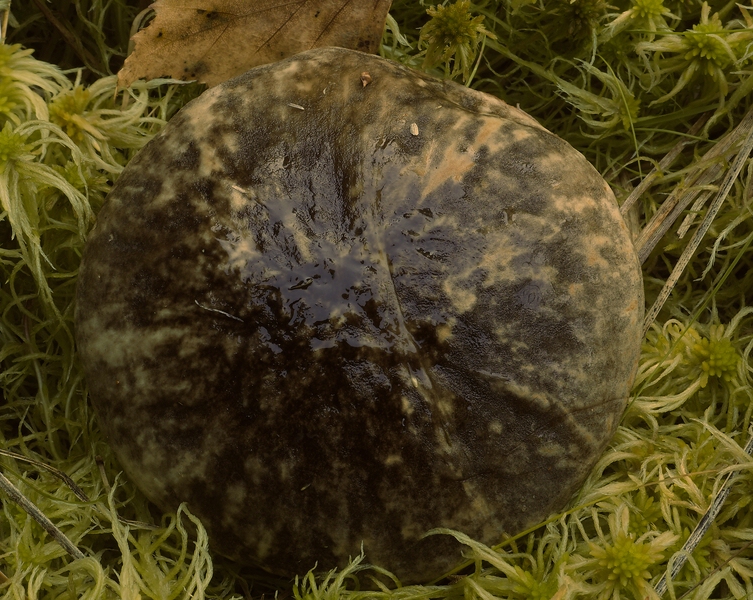
Credit: Peter Karasch
1.2 Species rich grassland, mountain pastures, extensive meadows
After the end of the last great ice age around 12,000 years ago, large tundra-like meadows emerged at the edge of the forests, which were populated by grass-eating animal species (herbivores). Forest-forming tree species gradually conquered large areas that only became grassland again through human use (clearing, cf. -reut, -reuth). These areas, either grazed or mowed once or twice a year for centuries until 60- 80 years ago, were largely very low in nutrients (< 12 KG N / ha), as artificial fertilizer or large quantities of liquid manure were not available. This old-fashioned form of agriculture has resulted in very species-rich grasslands, which provide habitat for up to 150 different herbs and grasses per hectare. Since an average of 5-6 species of mushrooms can be expected for each plant species, several hundred species of mushrooms can be expected on species-rich grassland. The higher the nitrogen and nutrient content of the soil, the lower the biodiversity up to extremely species-poor, high-performance grassland.
The most common habitat types in the Bohemian Forest are species-rich montane mat grasslands and mountain hay meadows (NATURA 2000).

you can find meadow mushrooms in autumn.
Credit: Gerhard Schuster

Credit: Felix Hampe
Due to the shorter vegetation periods and above-average number of smallholder structures, relatively high proportions of species-rich grassland can still be found in the highlands of the Bohemian Forest. Accordingly these areas contain rare plant, animal and mushroom species. Many of these species are included on the ‘Red lists’. In 2013 the nature reserve "Himmelreich" was designated in Deggendorf because of its many rare types of mushrooms. As part of an expert report (KRIEGLSTEINER 2008), a total of 630 mushroom species were identified in the open land and forested areas. These were distributed into the boletes (14 species), agarics including russuloide (305 species), gasteromycetes (16 species), aphyllophorales (124 species), rust fungi (10 species), smut fungi (125 species), ascomycetes (125 Species), zygomycetes (1 species) and slime molds (32 species).

Credit: Peter Karasch

Credit: Peter Karasch

Credit: Peter Karasch

Credit: Peter Karasch

at Zwieslerwaldhaus.
Credit: Peter Karasch

species-rich grassland.
Credit: Peter Karasch
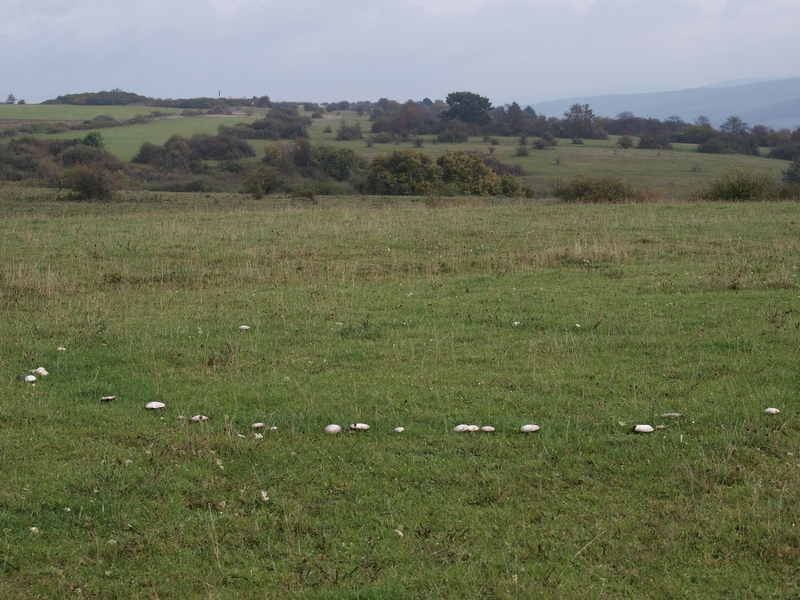

Meadow mushrooms are becoming increasingly rare. Credit: Peter Karasch

Credit: Peter Karasch
2. Forests
2.1 Beech forests
Central Europe is the main area of the European beech (Fagus sylvatica). Depending on the geology, exposure and small-scale climate, different types have developed. In the Bohemian Forest there are predominantly mixed forests of beech, spruce and fir due to the predominatly acidic soils of grove and woodruff beech forests. In the high altitudes forms of the subalpine beech forest with sycamore maple are found (NATURA 2000). The beech tree has several hundred species of fungi that can enter into a symbiosis (ectomycorrhiza). Some ot them are obligatory to beech, other species can form symbiosis with other tree species, too. Several hundred species of fungi are bound to the European beech, whether as symbionts, xylobionten or decomposers. RUNGE (1990) examined nine beech stumps (around 100 years old) for six years and found 51 species of mushrooms on them.

Credit: Lukas Haselberger

Credit: Peter Karasch
The European beech is also the main host of the tinder fungus

Credit: Peter Karasch
Old, weakend beeches will be infected by this parasite at some point. This creates valuable biotope trees (methusalems), which serve as a habitat for cave breeders such as woodpecker, hawk owl and pine marten. The tinder sponge was used by mankind in prehistoric times as a "lighter" and raw material for tindercloths, from which hats and other items of clothing are still made today.


has fallen over, the fruit layer realigns itself to the center of the earth. Credit: Peter Karasch

Credit: Gerhard Schuster

with the best edible mushrooms. Credit: Peter Karasch

in the autumn beech forest. Credit: Peter Karasch
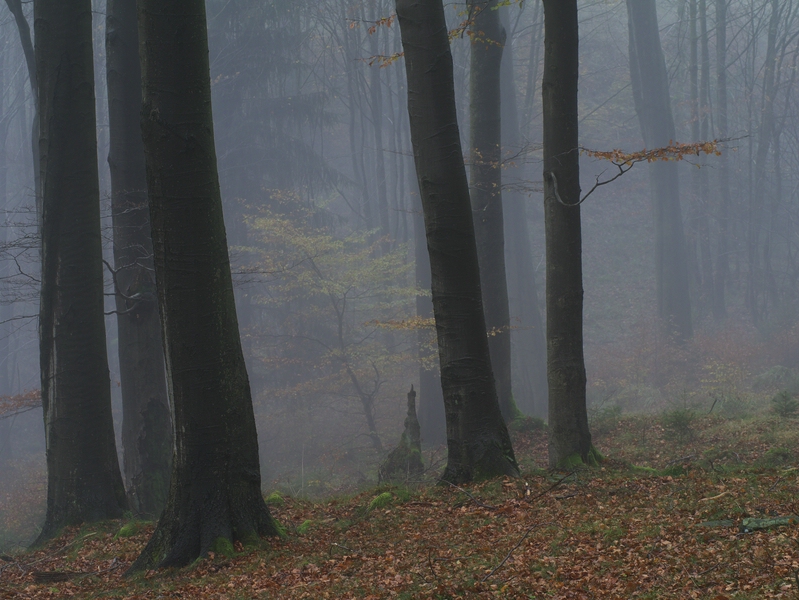
find fresh mushrooms. Credit: Gerhard Schuster

Credit: Peter Karasch

as critically endangered. Credit: Peter Karasch

2.2 Mixed mountain forests with beech, spruce and fir
In old forest relics, areas close to primeval forests and farmers' selection cutting forests, you can observe natural forest structures that could develop a more natural species composition without the planting of forestry trees such as spruce. Depending on the altitude and exposure, forest pines, oaks, sycamore maple are included. Pioneer tree species such as birch, mountain ash, willow and aspen are also found in such forests. These structurally rich forests are considered to be much more stable towards environmental influences outside the human control. If a tree species like the spruce with a share of 25% fails due to drought and bark beetle infestation, the resulting gaps are quickly closed naturally by other tree species. Forest intervention is neither intended nor necessary in natural forest systems. The natural material cycles are significantly influenced by fungi. The available organic material is gradually converted into plant-available nutrients by hundreds of species. In exchange for carbohydrates (sugar) the mycorrhizal fungi supply the trees with water and dissolved minerals.

Credit: Lukas Haselberger
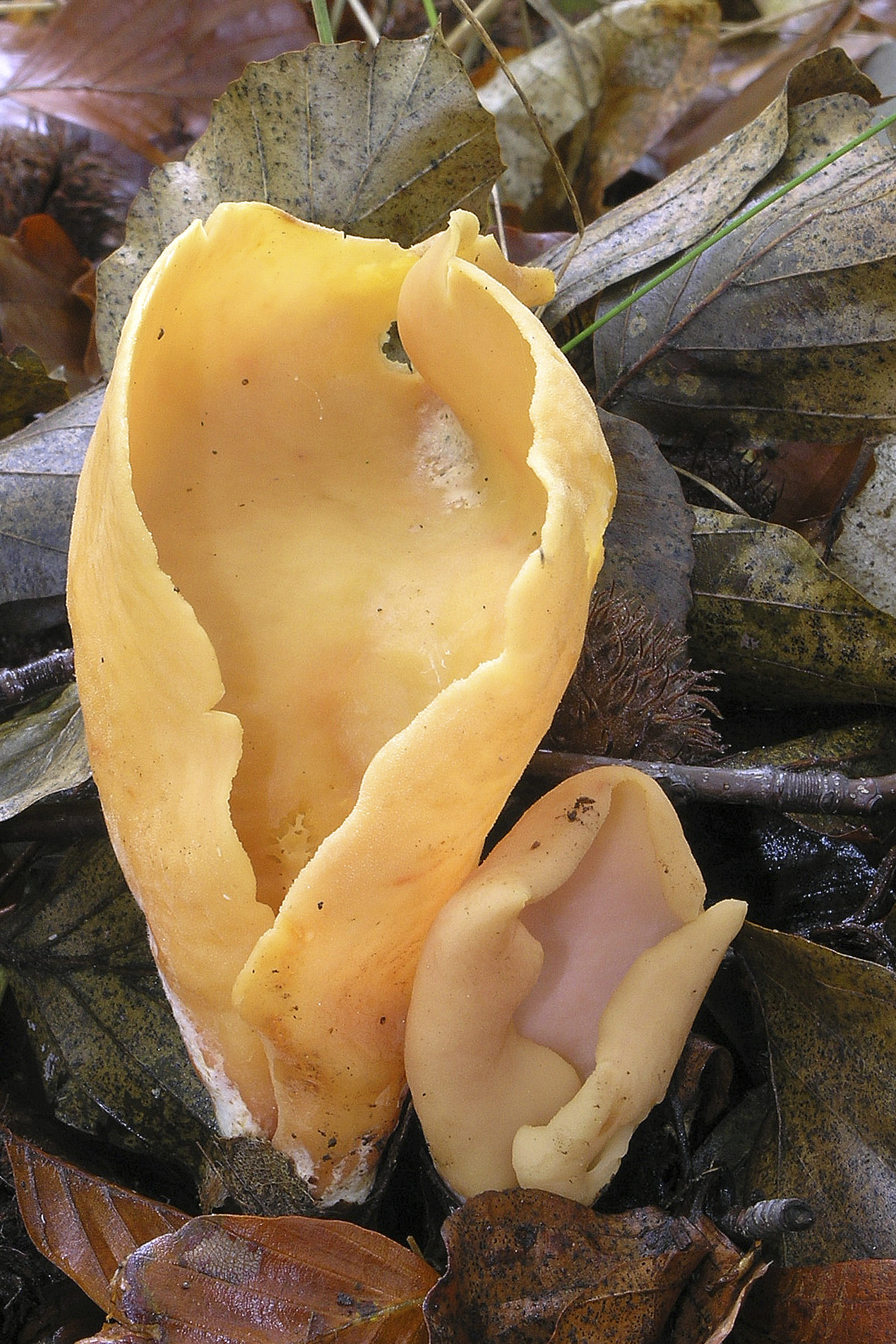
Credit: Dr. Matthias Theiss

Credit: Gerhard Schuster

Credit: Felix Hampe

Credit: Gerhard Schuster

the silver fir. Credit: Peter Karasch

Credit: Felix Hampe

Deforestation usually means the end for species that are weakly dispersed. Credit: Petra u. Werner Eimann

Credit: Peter Karasch

Credit: Peter Karasch

Credit: Gerhard Schuster

Credit: Peter Karasch
2.3 Spruce forests / timberland
During the time of the large forest conversion from the end of the 19th century, the wood requirement for mines, ore and glassworks and wood fireplaces was so enormous that the fast-growing spruce (Picea abies) was planted as a forest tree in large pure stands (monocultures) in large parts of Central Europe. From the 1980s to the present day it has become increasingly clear that this idea was a mistake in the generation project for forestry. The spruce was so fast-growing in pure stands because a part of its original symbiotic mushroom partner is very adaptable. These include e.g. toadstools, bitter bolete, blusher, coral, Paxillus involutus, Laccaria laccata, Lactarius and bay bolete, Russula ochroleuca and the edible bolete which can be found in almost all spruce forests. After about 30 years, most forests develop more stable mushroom communities after disturbances such as clear cutting and reforestation. Some of the mushroom species associated with spruce are popular edible mushrooms, especially the edible bolete.

Credit: Lukas Haselberger

Chanterelles are still as generous as they were a hundred years ago.
Credit: Peter Karasch

Credit: Gerhard Schuster

spread like the edible bolete. Credit: Gerhard Schuster
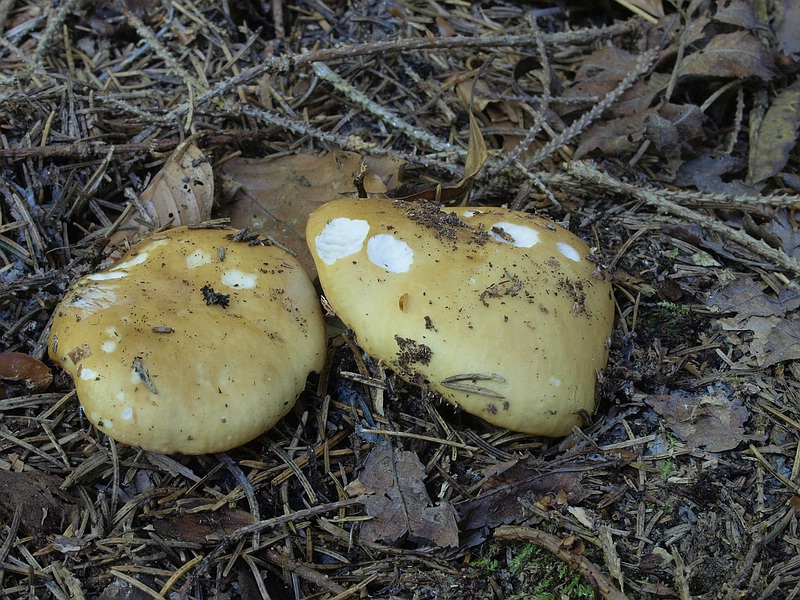

Credit: Peter Karasch

Credit: Peter Karasch

against nitrogen inputs and intensive thinning.
Credit: Peter Karasch

The spruce symbiont is due to nitrogen inputs and intensive forestry has become very rare.
Credit: Peter Karasch
2.4 Montane to apline acidic spruce forests
Where the spruce occurs naturally, above the altitude that is climatically suitable for the beech, you can find typical mushroom species communities on the acidic gneiss and granite surfaces. In the Bavarian Forest these can be found in the Arber and Osser region, at Falkenstein, Rachel, Lusen and Dreisessel. The spruce occurs here almost in pure stands, accompanied by mountain ash and occasionally birch.
The beautiful Russula paludosa is in the high-altitude spruce
forests on the Lackenberg are not uncommon.
Credit: Peter Karasch

Spruce stone mushrooms accompany their mycorrhizal trees up
to the tree line in subalpine locations.
Credit: Peter Karasch

natural mountain spruce forests z. B. find on Lusen.
Credit: Dr. Matthias Theiss

The mountain ash petiole dodger is in Germany
a rarity. So far he has been in Bavaria and the Bohemian Forest
only in the high elevations of the Lackenberg
fallen petioles of mountain ash found.
Credit: Peter Karasch

Rotrandporling the dominant wood-degrading fungus. He prepares the
Humus for the next generation of trees that is already growing.
Credit: Peter Karasch


Credit: Lukas Haselberger
2.5 Oak hornbeam forests and canyon forests in the Danube Valleys
The western project area border runs between Regensburg and Passau to Linz. On the mild vineyards along the Danube with steep rocky and dry slopes, light oak-hornbeam forests and noble hardwood forests with sycamore and linden trees have developed. Depending on the altitude, all transition stages up to the beech and mixed mountain forests are present. The forests dominated by oaks and hornbeams have their own mushroom community, even if there are overlaps in the habitats of some mushrooms.


Credit: Gerhard Schuster

Credit: Gerhard Schuster

Credit: Peter Karasch

Danube Leitenwäldern can be found in the immediate vicinity of the green leaf agaric.
Credit: Peter Karasch
The variety of fungi on oak is similar to that of the European beech. Hundreds of mycorrhizal partners, xylobionts and scatterers (saprobionts) live on and with oaks.





wie den Jochensteiner Hängen bei Passau. Bild: Gerhard Schuster

in die Wälder. Bild: Gerhard Schuster

Bild: Peter Karasch


Bild: Felix Hampe

Bild: Gerhard Schuster

zum Überleben braucht. Bild: Gerhard Schuster
2.6 Auwälder (Hart- und Weichholzauen, Fichtenauwälder
So-called riparian forests have developed on the edges of lakes, streams and rivers as well as in waterlogged locations, which contain mushroom species adapted to these habitats. Gray and black alder, ash and willow are found here as symbionts and host trees. Due to the challenging soil conditions, long habitat traditions could often develop in these areas and many species that are endangered today have been preserved.

Uferstreifen der Wolfsteiner Ohe finden.
Bild. Peter Karasch


auf der bayerischen Seite des Böhmerwaldes gelang 2017 am Ilzufer bei Passau.
Bild: Peter Karasch

Auwäldern finden kann.
Bild: Peter Karasch
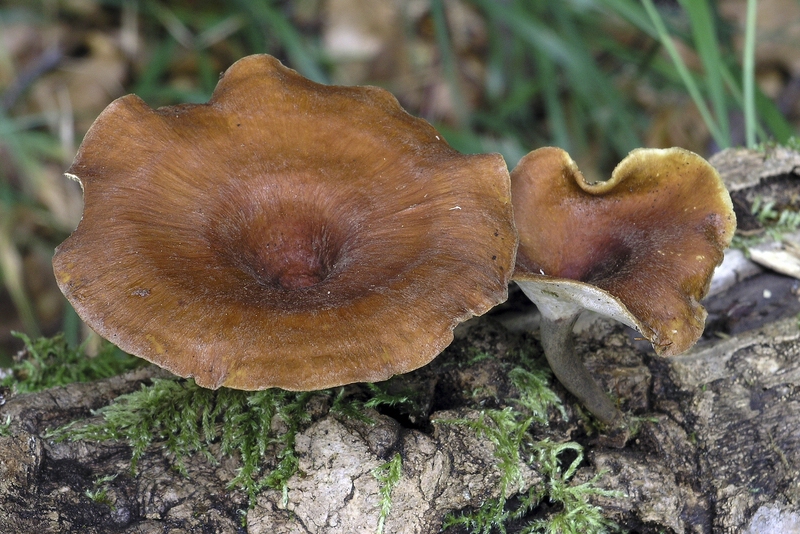
Weidensumpf entdeckt. Er ist deutschlandweit sehr selten und kann als Naturnähezeiger gelten.
Bild: Dr. Matthias Theiss

Wuchsort ist ein von vielen Bächen durchzogener Mischwald, teils mit Auwaldcharakter.
Bild: Peter Karasch
2.7 Latschenfelder (Buschvegetation mit Pinus mugo)
Mountain pines (dwarf pine) often form extensive fields on block rubble fields and slopes of the subalpine zones from 1100 meters, which are often covered by snow until April / May. In the Bavarian Forest you can find these bush forests on the Lusen and Dreisessel. Little has been researched mycologically in the Bohemian Forest, but it is known from the Alpine region that a few dozen species of mushrooms can be found here.


die schon während der Schneeschmelze wachsen.
Bild: Peter Karasch
3. Sonderstandorte
3.1 Dungpilze auf Kuhfladen, Misthaufen und Pferdeäpfeln
The "bender-biotop" is a well-established term in the mycologist scene in Germany for all the remains of animals, whether from traditional agriculture with manure piles or in the forest on deer and wild boar droppings. Mushrooms have conquered every conceivable organic niche over the course of millions of years and live in harmony with nature. Some types of dung mushrooms specialize in one species (e.g. marmot), others are widespread in the use of all kinds of domestic animals such as cows, horses, sheep and goats. In any case, their number and variety of forms is so enormous that some mycologists have specialized solely in researching this ecological group of fungi.

Bild: Peter Karasch

Schneeschmelze im Frühjahr erscheinen. Bild: Peter Karasch

der Schneeschmelze. Bild: Peter Karasch


Bild: Peter Karasch


wachsen auf Dung oder Stallmist. Bild: Peter Karasch
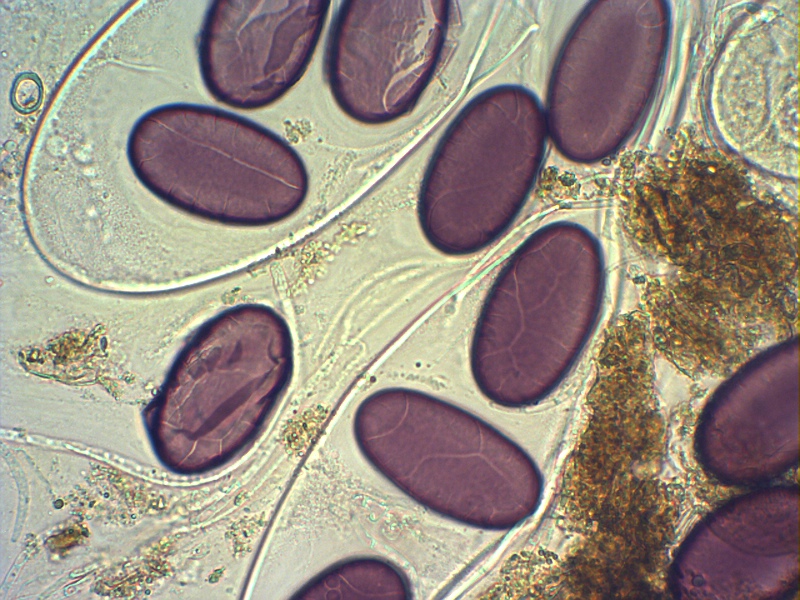
ornamentierte Sporen. Bild: Peter Karasch
3.2 Brandstellen
Forest maintenance with burnt spots and coal brewing are as much a part of the Bohemian Forest as the tradition of glass making. To prevent forest fires, this old tradition is no longer just restricted in many areas, but completely prohibited. The fact that hundreds of moss, plants, fungi and animals that need mineral-rich fire places as a habitat was either not taken into account in this decision or weighted differently. In any case, the ban on open fires means accepting the endangerment and possibly the extinction of many species.





auf frischen Brandstellen. Bild: Peter Karasch

4. Fließgewässer der planaren und montane Stufe
4.1 Bäche und Seigen
Especially in forest areas, large amounts of organic matter accumulate in slowly flowing streams, rivulets and drainage ditches. Bacteria and fungi can also use these food sources. More than 3000 aquatic fungi species are known worldwide. Many of them are microscopic, some larger species, often ascomycetes can be observed from branches or cones lying in the water starting in spring.

das ideale Habitat für den Sumpfhaubenpilz. Bild: Peter Karasch

Bild: Gerhard Schuster
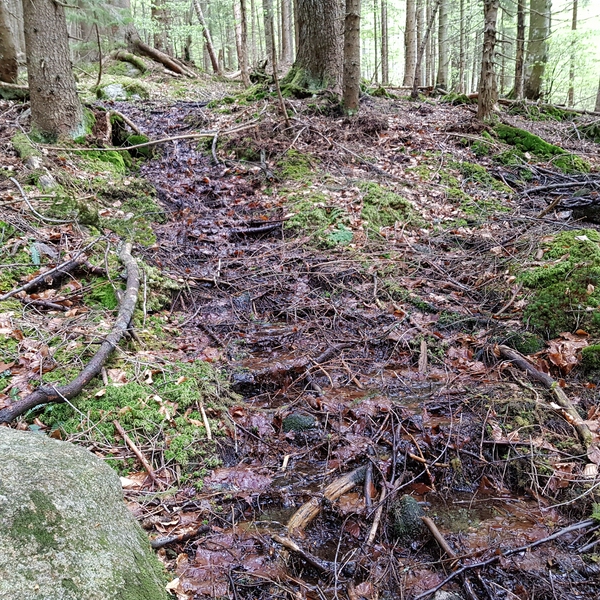


Bild: Peter Karasch

Bild: Peter Karasch

Bild: Andreas Gminder
Literature referenced in the text:
KRIEGLSTEINER L (2008): Pilzgutachten Himmelreich - Abschlussbericht (unveröffentlichtes Gutachten).
NATURA 2000 (2008): Management im Nationalpark Bayerischer Wald. Wissenschaftliche Reihe 17: 1-251.
NATURA 2000 (2018): Handbuch der FFH-Lebensraumtypen in Bayern.
